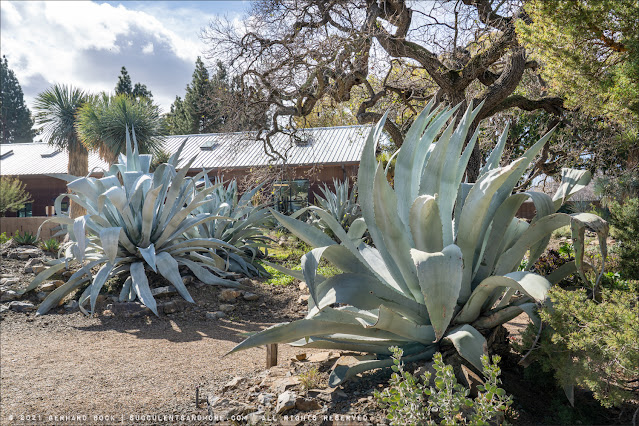I had the opportunity to visit the Ruth Bancroft Garden (RBG) twice in the last couple of weeks. I ran into curator Brian Kemble both times, and he shared a wealth of plant information with me, some of which I'm in turn sharing with you in the captions.
The RBG is looking fantastic this spring thanks to the hard work of the Garden crew and assistant curator Walker Young, the "custodian of the Garden's aesthetic." I took a few hundred photos. Even after whittling them down, I still had far too many for one post so I'm going to split them up into three. I hope you don't mind such a heavy dose of succulent beauty!
Let's start at the entrance. In the first photo below, you can spot the new Visitor and Education Center behind the majestic
Agave franzosinii, the Garden's sentinels:
 |
| Agave franzosinii |
 |
| Agave franzosinii; on the right, a closer view of the "lost wax" effect where the blue wax that covers the leaves is rubbed off as the plant grows |
 |
Agave franzosinii, with Yucca rostrata and Washingtonia filifera Phoenix canariensis towering above them |
 |
| Agave franzosinii as social distancing measure |
 |
| Agave palmeri 'Blue Meanie' planted in a crack between two rocks |
 |
| Agave utahensis var. eborispina |
 |
| Variegated Agave filifera, one of several offsets from a variegated plant in Brian Kemble's garden |
 |
| Visitor and Education Center |
 |
| Dudleya brittonii |
 |
| Eucalyptus macrocarpa |
 |
| Yuccaland |
 |
| Agave sp. between two Mexican grass trees (Dasylirion longissimum) |
 |
| Boojum tree (Fouquieria columnaris) protected by one of Ruth Bancroft's winter rain covers (February 13; on February 27, the cover was gone). The arching arm above is from a Joshua tree (Yucca brevifolia). |
 |
| Backlit clump of Opuntia sp. in front of Ephedra equisetina |
 |
| Different clump of Opuntia |
 |
| Dudleya and Ferocactus sp. |
 |
| Hesperoyucca whipplei on February 13 |
 |
| Two weeks later, on February 27, the flower stalk had shot up to its full height, and the flowers were starting to open up |
 |
| The flowers on this plant are particularly attractive because of the purple picotee effect. Typically, Hesperoyucca whipplei flowers are creamy white, with no contrasting color. |
 |
| Hesperoyucca whipplei, or Our Lord's Candle, is native to Southern and Baja California |
 |
| Agave 'Blue Glow' & co. |
 |
| Agave dasylirioides with its comically drooping inflorescence. This is a rare sight since this agave species is not often seen in cultivation. |
 |
| Agave dasylirioides |
RELATED POSTS:
© Gerhard Bock, 2021. All rights reserved. No part of the materials available through www.succulentsandmore.com may be copied, photocopied, reproduced, translated or reduced to any electronic medium or machine-readable form, in whole or in part, without prior written consent of Gerhard Bock. Any other reproduction in any form without the permission of Gerhard Bock is prohibited. All materials contained on this site are protected by United States and international copyright law and may not be reproduced, distributed, transmitted, displayed, published or broadcast without the prior written permission of Gerhard Bock. If you are reading this post on a website other than www.succulentsandmore.com, please be advised that that site is using my content without my permission. Any unauthorized use will be reported.







































Your photos are spectacular as always Gerhard, you capture the beauty of the plants and the place so well! Looking forward to part 2...
ReplyDeleteGlad you're along for the ride!
DeleteHad a giggle with the agave and social distancing sign. If ever there was a plant that typifies social distancing it's a large agave. Everything at the garden is looking great. What is the tall plant to the left of the visitor center? It really makes a statement. Looking forward to the next parts.
ReplyDeleteStay one Agave franzosinii apart - the best COVID advice, right?
DeleteThat was just wonderful. First I visited the UC Santa Cruz arboretum with Kathy and then I came over to this tab and visited the RBG with you... the day is off to a very good start! Now to visit them both in person...
ReplyDeleteCan't wait for that day!
DeleteI loved the photo of the Aeonium snuggled into moss. That Templetonia is a gorgeous thing too. I look forward to posts 2 and 3.
ReplyDeleteI planted a tiny Templetonia years ago and it's still tiny because it's getting shaded by a Cuphea. Need to move it!
DeleteSo many gems in this post. Templetonia, wow, picotee Hesperaloe, wow, lovely Dudleyas. Aloe microstigma is a favorite for me, also. Too bad I keep killing it.
ReplyDelete"Agave franzosinii, with Yucca rostrata and Washingtonia filifera towering above them"
I think that's Phoenix canariensis, actually.
YES, you're right about Phoenix canariensis. It's not the first time I've made that mistake. Palms are my Kryptonite :-)
DeleteDoes Aloe microstigma rot for you? I find it an easy one to grow, but I have problems with other aloes that I think do better in Southern California like A. alooides.